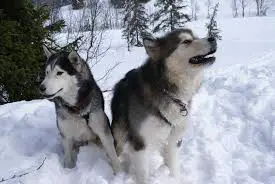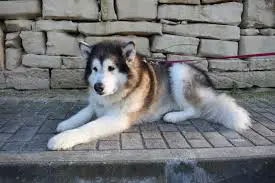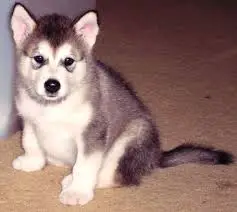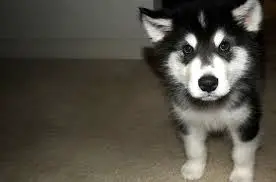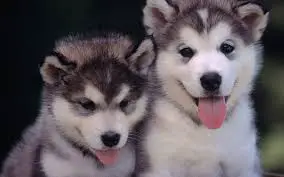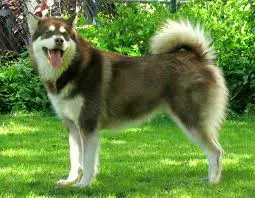Malamute Husky Mix
The Malamute Husky Mix, also known as the Alusky, is the result of breeding the Alaskan Malamute and the Siberian Husky. This is a medium to large dog with lots of energy that sheds a lot. He is intelligent, loving and loyal and makes a great pet anyone would love. Continue reading below to see pictures, videos, and learn more about the beautiful Malamute Husky Mix.
While we really recommend that you acquire all animals through a rescue, we understand that some people might go through a breeder to get their Malamute Husky Mix puppy. That is, if they have any for sale. Always screen your breeders as much as possible to ensure that you are getting as high a quality dog as is possible.
If you are interested in helping animal rescues raise money, please play our quiz. Each correct answer donates to help feed shelter animals.
Here are some pictures of the Malamute Husky Mix
Malamute Husky Mix History
This is a bit of a unique hybrid or mix dog as the two parent breeds are very similar. Both were bred to pull freight - the Husky much lighter freight over longer distances and the Malamute heavier freight over shorter distances. They also look a lot alike. If you are looking at breeders for new, designer dogs please beware of Puppy Mills. These are places that mass produce puppies, specifically for profit and don’t care at all about the dogs. Please sign our petition to stop puppy mills. Here is a brief history of both parent breeds so you get a better idea of what this mix might be comprised of.
The Siberian Husky is a medium size working dog breed that originated in north-eastern Siberia, Russia. The breed belongs to the Spitz genetic family and was originally bred to pull sleds over long distances rather quickly. They are known to be escape artists that will dig themselves out of the strongest fence. Being that they were bred to pull things you can imagine that they aren’t the easiest dogs to walk.
Alaskan Malamutes are still in use as sled dogs for personal travel, hauling freight, or helping move light objects; some, however, are used for the recreational pursuit of sledding, also known as mushing, as well as for skijoring, bikejoring, carting, and canicross. The Malamute has a long genetic foundation of living in harsh environments, and many of its behaviors have adapted to survive in such environments. The Alaskan Malamute had a prominent role with their human companions – as a utilitarian dog, working, hunting, and living alongside humans. The dogs were renowned for their excellent hunting abilities and were used to hunt large predators such as bears. They also aided their owners in finding seals by alerting to seal blow holes. The interdependent relationship between the Mahlemut and their dogs fostered prosperity among both and enabled them to flourish in the inhospitable land above the Arctic Circle.
For a brief period during the Klondike Gold Rush of 1896, the Malamute and other sled dogs became extremely valuable to recently landed prospectors and settlers, and were frequently crossbred with imported breeds. This was often an attempt to improve the type, or to make up for how few true Malamutes were available to purchase.
Awesome videos of Malamute Husky Mix puppies
Malamute Husky Mix Size and Weight
MALAMUTE
Height: 22 - 26 inches at the shoulder
Weight: 70 - 100 lb.
Lifespan: 10-12 years
HUSKY
Height: 20 - 23 inches at the shoulder
Weight: 35 - 60 lb.
Lifespan: 12-15 years
Malamute Husky Mix Personality
The Aluski is a very high energy dog that will do best with someone who has the time to give them the proper exercise. Both of these breeds were bred to interact with and live within a village of people. Therefore, they are usually easy to get along with and not one to alarm you to a new person. This doesn’t make them the best watch dog. The best thing you can do for these guys is to give them a sense of purpose. Make them pull a sled around the driveway. Let them let out their natural instinct to want to do something. They need very long walks, preferably hikes that let them burn off their excess energy. The best thing you can do for them is exercise and then socialize them. They are an easy-going dog, but they need to be socialized as much as possible. They are known for digging out of fences and always finding a way out. You will need to be very careful if you leave them outside alone.
Malamute Husky Mix Health
All dogs have the potential to develop genetic health problems as all breeds are susceptible to some things more than others. However, the one positive thing about getting a puppy is that you can avoid this as much as possible. A breeder should absolutely offer a health guarantee on puppies. If they won’t do this, then look no more and don’t consider that breeder at all. A reputable breeder will be honest and open about health problems in the breed and the incidence with which they occur. Health clearances prove that a dog has been tested for and cleared of a particular condition.
Do not purchase a puppy from a breeder who cannot provide you with written documentation that the parents were cleared of health problems that affect the breed. A careful breeder and one who truly cares about the breed itself, screens their breeding dogs for genetic disease and breed only the healthiest and best-looking specimens. One of the most common health problems with dogs is obesity. Keeping this under control is your responsibility.
Malamute Husky Mix Care
The Alusky should be relatively easy to train, but they also might be extremely stubborn and very hard to walk on a leash. They might try and drag you everywhere you go, so keep that in mind when trying to walk them. They are going to shed a lot and will do best in colder climates. Give them baths as needed, but not so much that you dry out their skin. Never tie your dog up outside - that is inhumane and not fair to him. The Malamute Husky Mix can be a great escape artist so if left in the backyard (temporarily of course,) they will be tough to keep in. You will need to make sure the fence is extremely secure and buried a couple of feet in the ground. Plan on taking them for extremely long walks and hikes to keep their energy level down.
Malamute Husky Mix Feeding
A lot of times diet is done on a per-dog basis. Each one is unique and has different dietary requirements. Most dogs in the U.S. are overweight. A mix like this one that is prone to hip and elbow dysplasia should really be on fish oil and glucosamine and chondroitin supplements as soon as possible.
Overfeeding any dog is not a good idea as that can really exacerbate health problems such as elbow and hip dysplasia.
A good diet to look into is Raw Food Diet. A raw food diet will be especially good for the Wolf background.

